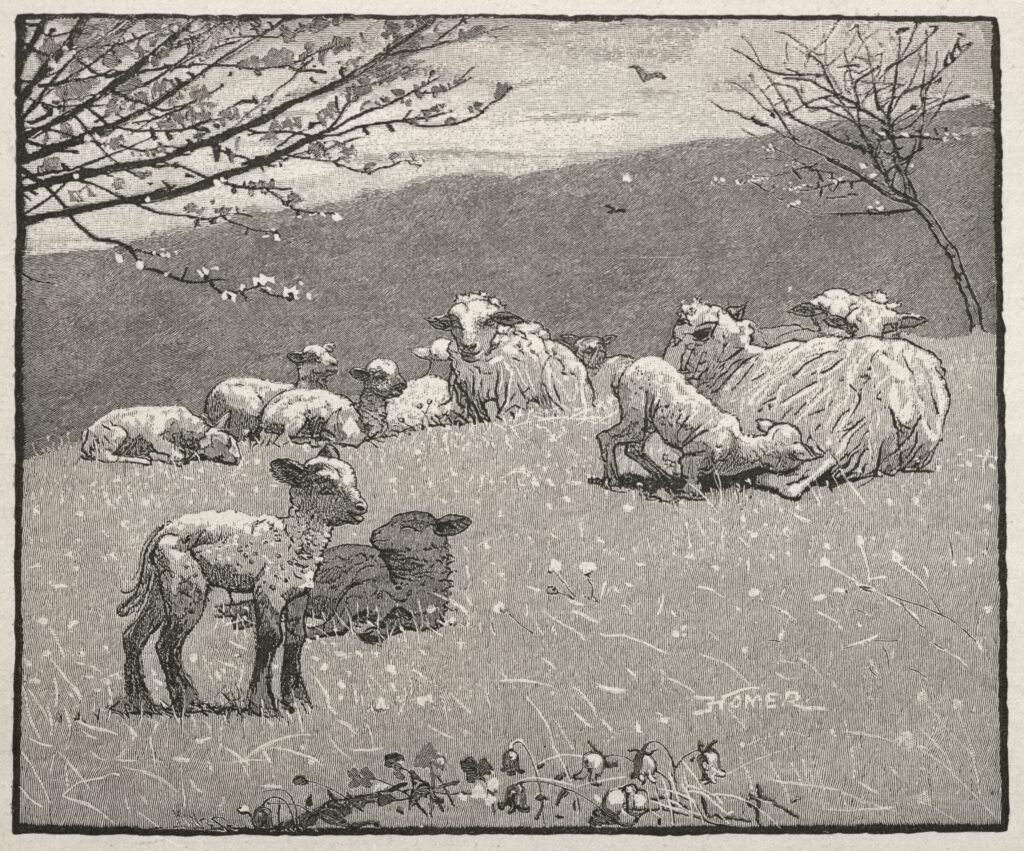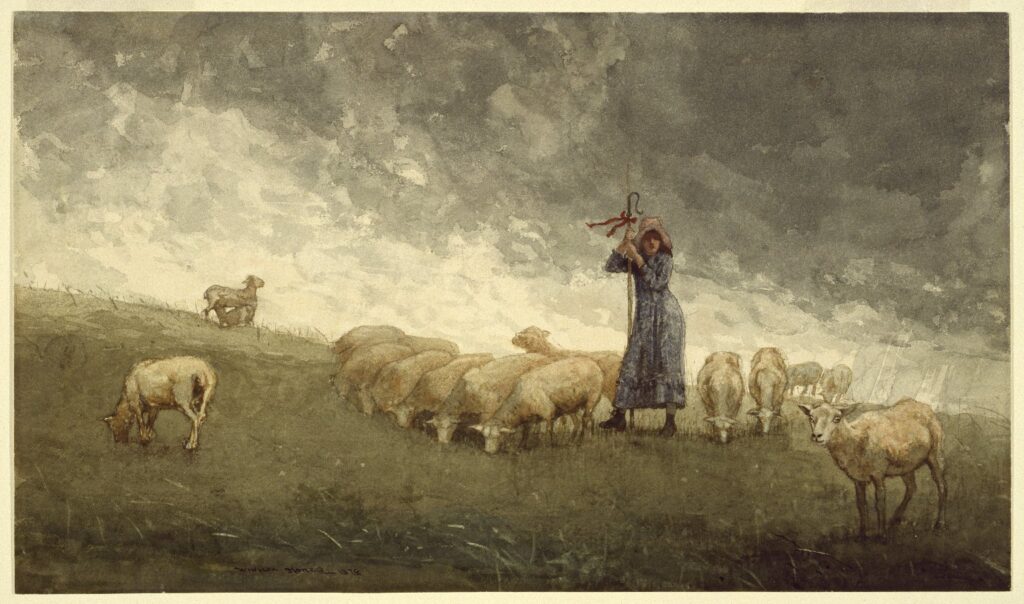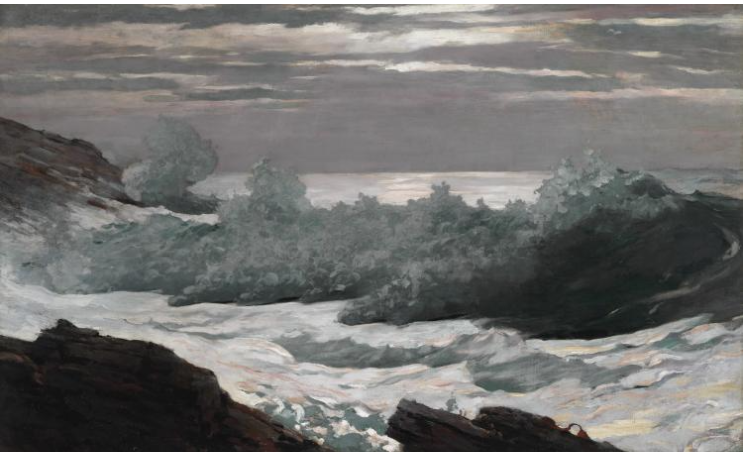The Blind Lamb
By Celia Thaxter
Annotations by Kathryn t. burt

'Twas summer, and softly the ocean Sang, sparkling in light and heat, And over the water and over the land The warm south-wind blew sweet. And the children played in the sunshine, And shouted and scampered in glee O'er the grassy slopes, or the weed-strewn beach, Or rocked on the dreaming sea. They had roamed the whole bright morning, The troop of merry boys, And in they flocked at noontide, With a clamor of joyful noise. And they bore among them gently A wee lamb, white as snow; And, "O mamma, mamma, he's blind! He can't tell where to go. "And we found him lost and lonely, And we brought him home to you, And we're going to feed him and care for him!" Cried the eager little crew. "Look, how he falls over everything!" And they set him on his feet, And aimlessly he wandered, With a low and mournful[1] bleat. Some sign of pity he seemed to ask, And he strove to draw more near, When he felt the touch of a human hand, Or a kind voice reach his ear. They tethered[2] him in a grassy space Hard by the garden gate, And with sweet fresh milk they fed him And cared for him early and late.

But as the golden days went on, Forgetful the children grew, They wearied of tending the poor blind lamb, No longer a plaything new. And so each day I changed his place Within the garden fence, And fed him morn and noon and eve, And was his Providence[3]. And he knew the rustle of my gown, And every lightest tone, And when he heard me pass, straightway He followed o'er stock and stone. One dark and balmy[4] evening, When the south-wind breathed of rain, I went to lead my pet within, And found but a broken chain. And a terror fell upon me, For round on every side The circling sea was sending in The strength of the full flood-tide. I called aloud and listened, I knew not where to seek; Out of the dark the warm wet wind Blew soft against my cheek, And naught was heard but the sound of waves Crowding against the shore. Over the dewy grass I ran, And called aloud once more. What reached me out of the distance? Surely, a piteous[5] bleat! I threw my long dress[6] over my arm, And followed with flying feet. Down to the edge of the water, Calling again and again, Answered so clearly, near and more near, By that tremulous[7] cry of pain! I crept to the end of the rocky ledge, Black lay the water wide; Up from among the rippling waves Came the shivering voice that cried. I could not see, but I answered him; And, stretching a rescuing hand, I felt in the darkness his sea-soaked wool, And drew him in to the land.

And the poor little creature pressed so close, Distracted with delight, While I dried the brine from his dripping fleece With my apron soft and white. Close in my arms I gathered him, More glad than tongue can tell, And he laid on my shoulder his pretty head; He knew that all was well. And I thought as I bore him swiftly back, Content, close-folded thus, Of the Heavenly Father compassionate, Whose pity shall succor[8] us. I thought of the arms of mercy That clasp the world about, And that not one of His children Shall perish in dread and doubt. For He hears the voices that cry to him, And near his love shall draw; With help and comfort he waits for us, The Light and the Life and the Law!
Thaxter, celia. 1872. “the blind lamb.” our young folks: an illustrated magazine for boys and girls, EDS. J.T. trowbridge and lucy larcom, vol. 8: 674-676. https://login.libproxy.uncg.edu/login?url=https://www.proquest.com/docview/137480100?accountid=14604.
[1] Expressing sadness, regret, or grief.
[2] Tied with a rope or chain.
[3]Protection or guidance from God, nature, or another spiritual power.
[4] Mild in temperature.
[5] Deserving or moving someone to kindness and compassion.
[6] A loose-fitting robe typically worn over nightwear.
[7] Nervous, shaking, or quivering.
[8] To help or give relief to someone suffering.
Contexts
According to Freeberg, the presence of blind people in America was largely hidden or ignored until 1832, when educational institutions for the blind were established in Boston, Philadelphia, and New York. For most sighted Americans who grew up with representations of blind people as helpless beggars in the Bible, “blindness seemed synonymous with dependency, marginalization, and poverty” (124). Moreover, while some Christians believed that blind children were being punished by God for an inherited sin, others rejected the notion that a good and just God would inflict blindness or visual impairment onto the innocent. However, nineteenth-century educators determined to help children with visual impairments went out of their way to not only improve the minds and independence of these children, but also to demonstrate to the public “that these children were apparently not bitter, but happy, not alienated from God, but thankful” (131). The lamb, a Christian symbol of innocence and purity, may be read in this poem as a stand-in for people struggling with physical disabilities who need a particular kind of care and support, but who may not receive it unless from particularly patient and compassionate individuals.
Resources for Further Study
- Freeberg, Ernest. 2002. “The Meanings of Blindness in Nineteenth Century America. American Antiquarian Society vol. 110, no. 1: 119-52.
- Protas, Allison, Geoff Brown, Jamie Smith, and Eric Jaffe. “Lamb.” 2001. Dictionary of Symbolism. Accessed 22 November 2020. http://umich.edu/~umfandsf/symbolismproject/symbolism.html/L/lamb.html.
- Holloway, Laura Carter. 1889. “Celia Thaxter.” In The Woman’s Story: As Told by Twenty American Women. New York: Hurst & Co., Publishers.
Pedagogy
Celia Thaxter was well-known for both her love of the sea and for her poetry that consistently reflected on themes of morality, human compassion, and faith (Holloway). How do you see these themes playing out in “The Blind Lamb”? What lesson are we meant to learn from the story within the poem? Why do the children cease taking care of the lamb? What does it say about the narrator that she not only continues to care for the lamb, but also puts her own life at risk to rescue it from drowning?
Contemporary Connections
There are several organizations today that seek to care for animals with physical disabilities, including blindness. You can see their work and learn ways to support it by visiting their websites: